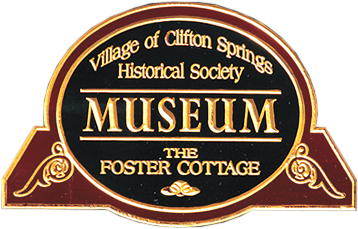Bath Treatments at "The Clifton Springs Sanitarium Company"
By Jim Conners, Village Historian
The present day hospital is a direct descendent of the 1850 Clifton Springs Water Cure, founded by Dr. Henry Foster.
A lot has changed in the last 153 years of continuous service at the hospital and there will be many changes in the future. To help
understand some of the changes about to happen at the hospital with the expansion of "The Springs of Clifton" we should take a look
at the history of the baths at the hospital.
Medical practices varied in the early 1800's as physicians learned about the various types of medicine and medical practices. At the
time the approved practice's consisted of bleeding, purging, blistering, sweating and the like along with use of powerful drugs. Dr.
Foster's medical specialty was in the field of homoeopathy, at a time when there was a call for a more natural and progressive medical
practices. Dr. Foster believed a physician needed to cure the whole person and that meant a plan was to address the body, mind and
spirit of the individual.
Clifton Springs was originally known as Sulphur Springs because of the mineral springs that run through the town. Even the Native
Americans believed that the waters had curative powers. Early settlers built baths at the springs to take advantage of the mineral
waters and collect it for medicinal purposes.
It was these sulphur waters that drew Dr. Foster to Clifton Springs in 1849 to open the Clifton Springs Water Cure. As part of
treating the body, Dr. Foster never allowed his medical research to become stagnant. By using both fresh and sulphur water for
hydropathical purposes and later the introduction of electricity, different types of baths became an integral part of the
patients medical program The baths were used in various forms for over 100 years.
There were several types of baths that the attending physician would prescribe based on his diagnosis. The baths along with a
well planned diet and exercises were all part of curing the patient's physical ailments. The baths which included fresh water,
sulphur water, and use of electricity were many and included; Nautheim Baths, Turkish Bath, Turkish Salt Rub, Vapor Bath,
Needle Bath, Compressed Air Bath, Sulphur Bath, Shallow Sulphur Bath, Plain Bath, Electro-Thermal, Electro-Chemical, Chest Weights,
Cupping Pump, Falling Douche, Rising Douche, Spinal Douche, Electricity (Galvanic, Faradic or Static), Fomentation (spinal),
Sitz and Foot Bath, Ice Bag, Massage, Machine Massage, Monroe Message, Head Massage, Sheet Pack, Soda and Salt, plus others.
As the knowledge of medicine grew and practices changed so changed the Clifton Springs Water Cure, which became the Clifton Springs
Sanitarium in 1871 and then The Clifton Springs Hospital & Clinic. With the changes, made with the best of intentions, came the end
of the sulphur baths at the hospital. However, persons at the hospital have been listening and learning and have come to the
realization that sometimes the ways of the past can once again become a part of the present. These medical treatments from the
past may be just what the patient needs to continue the healing process. With the growth of The Springs of Clifton, part of the
Clifton Springs Hospital and Clinic, we will soon be seeing a rebirth of the sulphur baths in Clifton Springs.
In the next article I will go into more detail about some of the specific baths listed above.
In the "General Instructions for Treatments" some special instructions were given to those attendants that administered the various
baths. Including; "Many persons are afraid of electricity in any form and great care should be exercised in the administration of
electrical treatments." "Special mention is made of the necessity of polite attention and a sympathetic manner in dealing with each
patient, showing no partiality or preference, but doing the utmost for each case, thus insuring the good will and hearty
appreciation of all efforts, and a ready response to the treatment given. Your personal influence will count for or against the
speedy recovery of every patient with whom you come in contact."
